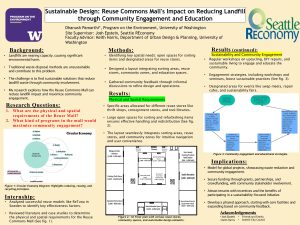Designing For Sustainability: The Role Of A Reuse Commons Mall In Reducing Landfill Impact Through Community Engagement & Education
The sheer volume of waste generated annually underscores the severity of environmental problems. In the United States alone, over 250 million tons of waste are produced each year, with a significant portion ending up in landfills. This not only leads to the loss of valuable resources but also contributes to extensive land use and environmental degradation. Landfills are major sources of methane emissions, significantly contributing to global warming. Addressing these issues necessitates a shift towards a circular economy, where resources are reused and recycled to minimize waste. The Reuse Commons Mall is designed to tackle this challenge by promoting sustainable reuse practices. During my internship at Seattle REconomy, I focused on researching and identifying the key physical and spatial requirements for the Reuse Commons Mall and creating a design for the Reuse Commons Mall. Extensive literature review and analysis of successful models like ReTuna in Sweden provided critical insights into best practices for reuse malls. The design includes primary reuse stores such as a furniture bank and lumber yard on the ground floor, ensuring these essential areas are easily accessible. Additionally, eco-friendly features like energy-efficient lighting, water-saving systems, and recycling stations emphasize the commitment to sustainability. Key findings demonstrate that well-designed spaces can significantly reduce waste and support sustainable practices. The Reuse Commons Mall serves as a model for other communities, showcasing the environmental, economic, and social benefits of reuse initiatives. The project not only provides affordable goods and skill-building opportunities but also raises awareness about sustainability through educational outreach.
